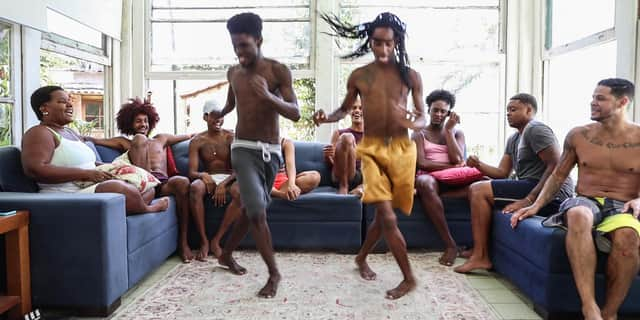EIF review: Dancing in the Streets


Each artist received the same commission yet the results could not be more different, due in part to the individual choreographer’s styles but also the social and political landscapes of the locations – Rio de Janeiro, Beirut, Soweto and Edinburgh.
That these films were made under difficult circumstances is not lost - and all four would have benefited from more dramaturgical shape and planning. But, in their own very distinct ways, they each offer a snapshot of life in 2020/21 that is informative, thought-provoking and consistently engaging.
Advertisement
Hide AdThe dancers in Alice Ripoll’s Suave company (****) have spent the pandemic in the packed, often violent favelas of Rio, with little access to employment. Thinking they had a tour ahead of them, they re-grouped in a rented house, ready to rehearse in isolation. When the tour was cancelled, they made this film instead - 55 minutes of what Ripoll calls ‘Chronicles of life and dance’. Not all the footage deserved to make the cut, but it’s well worth sticking in for the golden nuggets of dance. Born out of house parties in the favelas, the ‘Passinho’ style is so fast-paced and energetic, you wonder at times if the film has been speeded up (it hasn’t).
Taking it in turns to demonstrate their skill, the dancers cheer each other on, clearly delighted to be back together again. When they’re not dancing, the Suave members share thoughts on their artistry, have fun in the swimming pool and impart local knowledge about the Passinho scene. You can, we’re told by dancer Ronald Sheik, tell which favela somebody comes from purely by the way they dance. During his own brief bursts of movement, Sheik is a sight to behold - lightning-quick legs and every muscle in his body playing its part.
Lebanese choreographer Omar Rajeh (***) has a similarly watchable quality - one of those rare soloists you can’t take your eyes off once they start dancing. His is one of three solos that make up the film, although Beirut itself feels like a partner in all of them.
Rajeh’s performance base was pulled down in August 2019 – a year later, the entire city was rocked by an explosion. Twelve months after that, he has created Three solos, Three questions. Quite what Rajeh is asking is unclear, let alone the answers - but at the very least, the solos give us pause for thought about how we take care of our cities, and where people fit into an often brutal concrete landscape.
The film features a number of arresting images, often captured via drone footage that peers down on the city below before zooming in on a dancer, or pulling away to reveal where a solo has taken place. The soundtrack of bleeps, static noise and what feels like a guitar tuning up isn’t easy on the ear – although the ringing sound accompanying Rajeh’s solo helps conjure up the aural after-shock of an explosion.
Gregory Maqoma’s Retrace-Retract (****) has a very different vibe, for despite the serious message it sets out to impart, it’s mostly done with levity and humour. Although born and raised in the South African township of Soweto, Maqoma now spends most of his time elsewhere. So the film opens with him being encouraged to ‘go back to where it all began’, as we vicariously experience the highs and lows of Soweto life through his eyes.
Advertisement
Hide AdAided by the poetry of Jefferson Tshabalala, Maqoma questions the wording of his country’s constitution – with declarations such as ‘The land shall be shared among those who work it’ to ‘those who own it’. Dressed in sharp suits, a trio of dancers mock the level of corruption in South Africa, with gold bling juxtaposed against life in a tin shack with a leaking roof. Throughout, the vibrant dance style of Pantsula, born in the Black townships, drives the action.
Janice Parker’s contribution (***) started life as something quite different. Each morning since the start of the pandemic, Parker has headed to Edinburgh’s Holyrood Park to move her body and convene with nature. Seven months later, she began filming herself with an iPhone (propped up on nearby rocks or trees) to share on social media. Those captured moments have now been re-edited as Small Acts of Hope and Lament and sliced into a triple-screen presentation.
Advertisement
Hide AdParker is better known as a choreographer and facilitator than a performer, creating powerful works with community dancers. At 63, she’s aware of her physical limitations but rightly points out during her voiceover that “we don’t need to be elite movers to be beautiful dancers.”
Taking us through the seasons, in sunshine and snow, from bare feet to wellies, Parker swings on branches, is glimpsed through blades of grass, paddles in streams. The ambient soundtrack features everything from a passing helicopter to the rustle of autumn leaves beneath her. To quote Parker, this is a “private dance in a public space”, a personal venture shared with an international audience that hopefully inspire others to embrace life as she does.
A message from the Editor:
Thank you for reading this article. We're more reliant on your support than ever as the shift in consumer habits brought about by coronavirus impacts our advertisers.
If you haven't already, please consider supporting our trusted, fact-checked journalism by taking out a digital subscription at https://www.scotsman.com/subscriptions